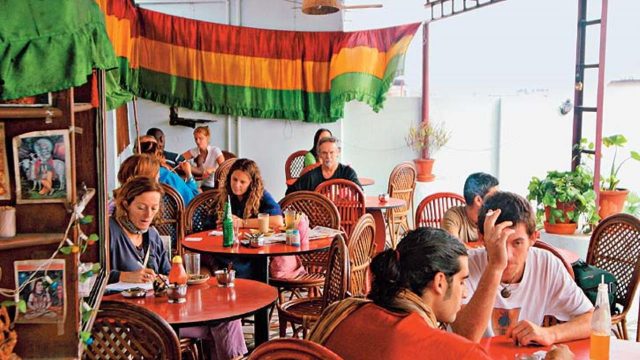Most foreign backpackers I meet in India look aghast when I tell them that I live in Delhi. To many of them, Delhi is summed up by the Red Fort and cycle rickshaw rides around Chandni Chowk at best, grimy train stations and stoned child beggars at worst. Most stay in Paharganj, the cheap accommodation ghetto across the street from New Delhi Railway Station, although a few end up at one of the run-down guesthouses in Connaught Place or Karol Bagh. Few venture beyond the older parts of town. For many—as it was once for me—Delhi is a mere transit hub, where you can pick up foreigner quota tickets from the Railways’ International Tourist Bureau and then head to some little piece of bohemia.
On my first visit to India, I came as a solo budget traveller, and Delhi was my first stop. Friends from the US who had already ‘done India’ had advised me to skip the backpacker bedlam in Paharganj (inevitably mispronounced ‘paaraganj’) and head straight to somewhere more, in their words, ‘shaanti’. I ended up booking a hotel in Majnu-Ka-Tila, a quiet Tibetan enclave in northeastern Delhi. There were plenty of other foreign tourists in the area, some who were there to imbibe a bit of Karma Cola of the Tibetan Buddhist variety, and others who had perhaps sacrificed the convenience of staying in Central Delhi to be spared the crowds, traffic and constant drone of “come look at my shop” that one has to put up with in the more touristy parts of town.
Others opt to stay right in the middle of the action, in one of Connaught Place’s famous guesthouses. Ringo Guest House (011-23320605)—a weathered, four-decades-old guesthouse behind the long string of souvenir shops on Janpath—is perhaps one of the best-known backpacker digs in the area. Its big draw used to be a shared dorm room, which manager Ajay Kumar explains, was shut about three years ago due to theft issues. Still, Ringo’s is well known among backpackers as a good place to meet potential travel buddies.
But while institutions such as Ringo’s continue to draw a handful of travellers to Connaught Place, Paharganj remains the granddaddy of backpacker ghettos. The average Dilliwala will tell you that Paharganj is shady, dirty and full of drug dealers, but this doesn’t seem to have deterred backpackers. It’s not like the choices for budget accommodation in Delhi are limited to only a few key spots—there are scores of options in Karol Bagh and the areas around Old Delhi’s train station, yet few foreign backpackers stay there. Sarina Singh, senior author of the Lonely Planet India guidebook, has a theory: “I’ve noticed how keen most backpackers are to stay in areas that attract fellow backpackers,” she says. “I think this is largely because Delhi is perceived as a challenging destination for foreigners (vis-à-vis scams), with the backpacker ghettos proffering comforting familiarity and insulation from the tumult.”
But it’s not just fresh-off-the-boat backpackers who are drawn to the notorious neighbourhood. Take the example of Meredith ‘Dwan’ Hachemeister, an American exporter who sources garments from India for her fashion line Dwanjabi. Hachemeister, who has been in and out of India for nearly a decade, usually bases herself out of Paharganj, often to the dismay of her local friends. “There is something to be said about the whole scene there…sitting in the bustling area enjoying a chai and watching the mélange of all who dwell there: newbie Western travellers, the seasoned leathery-skinned full-season dwellers, the business people who have an eye for making an easy rupee off the foreign tourists, the random people of the area…it is all so amusing,” she explains. “And in the mix of it all, I can’t go more than 15 minutes without seeing another familiar face of someone I’ve met during my travels to other parts of the country.”
Of late, though, many shoestring travellers are opting to stay in different parts of town, including the nearby Arakashan Road. There’s also a new breed of travellers, known colloquially as ‘flashpackers’, who travel using a mix of budget and midrange options, travelling by local bus and using the money saved to splurge on more comfortable accommodation than Paharganj has to offer. But a casual stroll through Paharganj’s main bazaar these days makes it clear that it’s not just the touts and lack of quality accommodation that’s driving tourists to other parts of town. Sections of the main road have been turned into rubble, seemingly in a last-minute attempt to widen the thoroughfares before October’s Games. While there’s no denying the long-term benefits that such a revamp might have on Paharganj, it’s nearly impossible to manoeuvre the heaps of stones that the road has become, much to the detriment of local businesses. Deepak Kanojia, manager at the Vivek Hotel’s rooftop restaurant, Sam’s Café (46470555), a backpacker favourite, has seen a significant drop in the number of diners at the popular restaurant. “We have 25 per cent less customers than one month back,” he says. “Some of the shops downstairs are even closing down.”
Despite Delhi’s seemingly unending pre-Commonwealth facelift, it’s unlikely that the budget travellers who pass through Delhi will flock en masse to a new part of town. A few will, of course, seek out alternative places to stay, but many travellers, keen on experiencing what is known in the backpacker mythology as the ‘real India’, are unlikely to forego the shops hacking Ali Baba pants and the restaurants serving Israeli salads in favour of the international showrooms and hip cafés of South Delhi, even if they can afford it. And as long as their expectations of what Delhi is supposed to be continue to be met, I expect they will remain shocked when I tell them that I have made Delhi my home.




